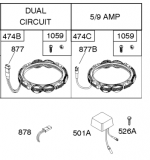Hello folks,
my used MTD (13dh452e676) had his cables fiddled around with (very badly that is). Also the charging wires have been disconnected.
So I went trying to fix it. Found out that the engine has a two output wire from the alternator, one with a diode and one with pure AC for lights.
There is no regulator, none at all (there are some holes left of the oil fill/oil rod that looks like where a regulator would go, but that's most likely a placeholder (?)).
So I checked the voltage at the diode output, and at "DC" it reads about 27/8 volts at full throttle, but goes as low as 11-12 volts with throttle at lowest point. Checking with "AC" one the multimeter, it reads about half of 27 (13-14 that is). The diode is fine, checked it and the results are good as a diode would be.
Checking the briggs manuals, they say that no regulator is needed with a single diode output. But the high voltage at DC checking worries me a lot, I don't want no battery acid spraying under my seat...
As I connected the diode output to the battery, and checking it then, the voltage raised (quite quickly actually) at the battery terminals (for like 2-4 seconds before I disconnected it).
Is this normal? Do I need one of those super-overpriced regulators? The engine parts diagrams show nothing useful, but the mower parts diagram don't show any need for a regulator.
Briggs model is 217807, type is 0426-B1.
Thanks in advance!
my used MTD (13dh452e676) had his cables fiddled around with (very badly that is). Also the charging wires have been disconnected.
So I went trying to fix it. Found out that the engine has a two output wire from the alternator, one with a diode and one with pure AC for lights.
There is no regulator, none at all (there are some holes left of the oil fill/oil rod that looks like where a regulator would go, but that's most likely a placeholder (?)).
So I checked the voltage at the diode output, and at "DC" it reads about 27/8 volts at full throttle, but goes as low as 11-12 volts with throttle at lowest point. Checking with "AC" one the multimeter, it reads about half of 27 (13-14 that is). The diode is fine, checked it and the results are good as a diode would be.
Checking the briggs manuals, they say that no regulator is needed with a single diode output. But the high voltage at DC checking worries me a lot, I don't want no battery acid spraying under my seat...
As I connected the diode output to the battery, and checking it then, the voltage raised (quite quickly actually) at the battery terminals (for like 2-4 seconds before I disconnected it).
Is this normal? Do I need one of those super-overpriced regulators? The engine parts diagrams show nothing useful, but the mower parts diagram don't show any need for a regulator.
Briggs model is 217807, type is 0426-B1.
Thanks in advance!

